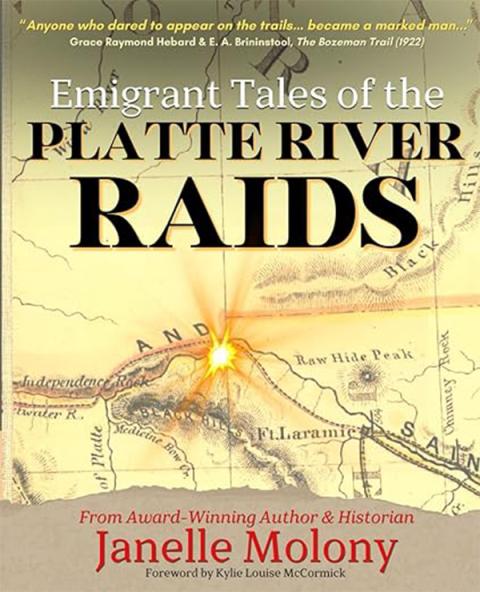On the Trails in a Dangerous Year
Emigrant Tales of the Platte River Raids: An 1864 Trail Diary Companion, by Janelle Molony. Foreword by Kylie L. McCormick, assistant editor, WyoHistory.org. M Press Publishing, Phoenix, Arizona, 2023, 524 pages. $34.00 paperback, $21.99 e-book.
The award-winning author/historian is a great-granddaughter of James and Sarah Rousseau, who traveled in 1864 with the Pella Company on the Oregon Trail on the south bank of the North Platte River through what’s now Wyoming. That was a particularly bloody year on the trails. The Civil War drew nearly all the Army’s attention and troops to the East, yet emigrants continued flooding west, many of them to escape the war. And the tribes resisted.

The book gives background and context for the accounts of nearly 70 diarists who traveled the trails that year. Molony in her preface offers something of an apology for telling only the emigrants’ side of events: “I wish to acknowledge that there is a side to this story that is not well represented. An authoritative, descendant-informed, and mapped-out account from the perspective of the Northern Plains Indians is desperately needed before too many conclusions can be made. If there is any perception that I am speaking on behalf of their people, it is unintentional. Until that enrichment occurs, the narrative of the emigrants, as presented here, must humbly be considered lacking and biased.”
The book is organized according to which Platte River trail emigrants traveled on: the south or north bank. Each section begins with an introduction to the people, by their company names. These names are usually of the families leading the wagon trains.
These introductions, fully sourced, include a detailed roster of all the families plus a narrative of events occurring as they travel. Information about the various trails precedes the author’s accounts of the actual journeys.
The accounts include maps, sketches, mileage and destination lists, quotations from various diaries and copious information about assorted stopping points. Not all the diary entries are directly about raids; some include information about military involvement and effort to safeguard the emigrants.
Sarah Rousseau noted on July 5, 1864, “Passed over this morning a desolate barren region of the country. Seemingly not fit for man or beast. Very poor grass and little of it.” Later that day they came upon friendly Pawnees. Sarah wrote, “Came by about 20 Wigwams, and as a matter of course there are plenty of natives.”
When the company came in sight of Laramie Peak, Sarah wrote, “...Passed quite a village of Indians. I suppose there was at least 40 wigwams. I can’t tell how many Indians. They make quite a curious appearance. Some about naked. And some dressed up in thick Buffalo skins while other have some kind of shirt or old dress.”
Although these entries are not bloodcurdling, many are, including an account of children kidnapped and, in at least one case, killed.
An appendix of newspaper articles, letters and oral histories adds to the book’s already plentiful sources. Kylie L. McCormick’s excellent Foreword provides extensive historical background to the events chronicled in the book.
The curious reader can open the volume to almost any page and find something interesting. Hence, this first-rate work of history need not be read front-to-back.
Available at janellemolony.com and on Amazon.
